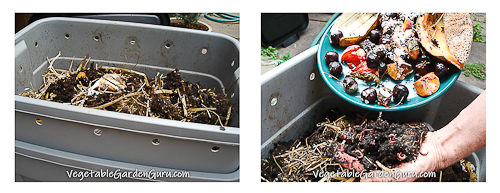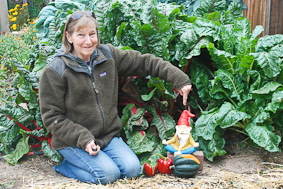The Fun of Worm Composting
Winter Entertainment: Make This Easy DIY Worm Bin and Have Worm Castings by Spring Plantout

Worm composting is a fun and easy way to generate the most nutritious compost possible for your vegetable garden. It is so nutritious it might even be considered fertilizer!
Not only is it a concentrated source of mineral nutrients, it also provides your soil a huge dose of the beneficial microbes that are the very cornerstone of living, healthy soil.
The reason worm castings are so concentrated is that while the worms eat all the kitchen scraps, they mostly just use the carbon and nitrogen energy sources, leaving behind many of the minerals to be excreted.
A properly-managed worm bin also speeds up the composting process, converting most kitchen scraps into a soil-ready form in a few weeks, rather than the few months it usually takes for traditional compost.
My original DIY worm bin was made of two stacking Rubbermaid tubs, a 10-gallon one on the bottom (without its lid), and a 14-gallon one nestled inside that,
resting on bricks in the bottom of the smaller one (two ten-galloners would work just as well). I have since replaced my Rubbermaid setup with a Hungry Bin™, but I'll describe how to make the original DIY worm bin. It's a great way to get started and get the hang of worm composting before making a big investment.
Constructing the worm composting bin is a snap. You can buy the two tubs for about $18. at Home Depot.
The bottom bin is just as it came, without any modifications. The lid is set aside. Set the two bricks in the bottom to help support the top bin.
The top bin has its lid, as-is, without holes. For the top bin itself, I drilled a series of 3/8" holes around the upper sides for aeration, as well as a couple dozen 3/16" holes in the bottom of the upper bin for drainage.
The food, bedding, and worms go in the top bin, where the worms mostly stay, chomping on the fresh food. The bottom bin captures drainage (sometimes called "worm
tea") and whatever worms fall or crawl through the holes.
Putting some moistened bedding in the bottom bin helps any worms that fall through to survive until you can return them to the top bin. Check it frequently.
I honestly LOVE my worm bin. What happens in there is really rather miraculous, and is happening in undisturbed, natural soils all around the world, helping recycle death back into life.
For a complete tutorial on setting up and managing your worm bin, please visit the full article at
Worm Composting.
It has all the details about what to use for bedding, how and where to set the bin up, how and what to feed the worms, all about harvesting castings, and more.
Now... I put this next article last so that you wouldn't hang up on me right away.
But the topic concerns us all, it's important, and I'm writing about it because I love you. (Yes… really.)
And the worm bin you're going to make this winter is part of the solution!
Soil Health and Human Health
are Directly Connected
There is a problem many people are still unaware of. "OH goodie, just what we need! ANOTHER problem to worry about!".
But there is a solution, too, and it can start in your garden. Please read on, brave gardener, and up your gardening game next year! It will one of the most empowering things you can do in these crazy times.
The Problem:
Soil health is declining, in lockstep with a decline in overall human health - specifically the rapid rise in the so-called "Diseases of Civilization": type 2 diabetes, heart disease, cancer, autism, autoimmune diseases, Alzheimer's, and many other illnesses. While correlation does not mean causation, there are some powerful indicators of a direct connection between the decrease in the nutritional content of foods and the rise in these diseases.
But what does soil health have to do with nutrition and in turn, human health? Turns out, EVERYTHING!
Everything that our bodies are built of comes from
an interconnected chain of being that originates in the soil. Bacteria, fungi and innumerable other species of organisms each have a specialty job to do in the recycling of carbon, nitrogen and minerals from dead plants into the roots of living plants.
Without these recycled-food preparers ("chefs") and the fungal delivery systems ("waiters"), the minerals, carbon, nitrogen and everything else our bodies are built of would not make it into plants, and eventually into us.
There was a dentist in the 1930's named Weston A. Price, who began to notice in his practice a marked difference between the "dental arches" - the bone structure that teeth are anchored into - of people who grew up eating ancestral diets from rich healthy soils, and those of people who grew up eating a modern diet from worn-out agricultural soils.
The differences were so striking and alarming that Dr. Price decided to travel the world to study, photograph and document this
phenomenon. He searched out places where there were still native people living on the ancestral foods of the land, grown using traditional farming methods, alongside another population of the same people who had moved off the land and adopted the diets of modern "civilization".
Bottom line: the mineral nutrition of the ancestral foods from mineral-rich, healthy soil ecosystems gave rise to children that developed perfect dental arches with straight teeth and no cavities, while the foods of modern civilization gave rise to children with underdeveloped dental bone structures, crooked teeth, and rampant cavities.
His studies could not be repeated today, because there are so few people left on earth not affected by modern agriculture, depleted soils and the depleted nutrition in food.
This is not just about cavities or crooked teeth due to underdevelopment of the jaw… those were merely early warning signs.
Modern agricultural
practices have had disastrous consequences for both soil health and human health. Tillage, chemical fertilizers, pesticides and herbicides have killed the below-ground ecosystems that feed plants their own healthful diet of minerals, which the plants in turn pass onto us… or used to.
And now, 90 years later, we have additional factors that have accelerated the decline in nutrition.
During the so-called "Green Revolution" of the 1970s the race was on to develop new hybrid varieties of rice, wheat, corn and other crops that could be harvested earlier and be higher in calories, so that we could "feed the world". This might have been a noble goal, but it brought a host of devastating unintended consequences, including more calories but lower mineral levels. For more details see
The Failure of The Green Revolution.
Now recent studies have shown that the increase in carbon dioxide in the atmosphere is making plants grow faster, which makes them larger in less time. You'd think that would be a good thing, right? The problem is, they build more sugars, but they don't take in more minerals, so the mineral levels are even lower for the same amount of food. We eat, but never quite feel satisfied, and our cells are actually starving for nutrients.
The lack of adequate minerals in the diet means that many of us no longer have what it takes to efficiently run the body's fundamental biochemical processes.
For a quick, mind-boggling and awe-inpiring view of the wonder of these processes, take a glance at the
Roche Biochemical Pathways Chart,
and scroll around and zoom in and out. Every cycle you see requires minerals. If they are lacking, little by little things get out of whack and… well, that's what our modern diseases are.
But there are things we can do to protect ourselves, our families, and eventually, our planet!
The Solution:
1) Learn to heal your soil and grow as much of your own highly nutritious food as possible, while teaching your kids gardening skills. You can learn about practices to heal your soil at
Regenerative Agriculture at Home.
2) Supplement your diet: add a sprinkle of kelp powder to whatever you're cooking, and take mineral supplements. (Talk to the nutritionist at your local health food store). While you're at it, quit sugar. Metabolizing it depletes the body's mineral stores.
3) Support your local regenerative farm by joining their CSA program or buying from their weekly farmers market.
4) Follow the work of the
Bionutrient Food Association,
which is applying cutting-edge scientific understanding of nature's processes to the restoration of soil health and nutritious food. Support them if you can.





